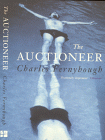
The Auctioneer
The Auctioneer Charles Fernyhough 4th Estate London 2000 340pp £6.99 1857029836
Merchandise Links
UK Edition: Amazon.co.uk |
As bookshelves groan under the weight of “Lad” and “Ladette” writers eager to reflect the stress and pace of modern life with its Scylla and Charybdis of bad sex and flat beer, it is refreshing to discover a writer who challenges his readers. Charles Fernyhoughs debut novel is not an easy book, but it is one which repays being read more than once.
The Auctioneer centres around the experiences of Finn Causley, who falls in love while travelling one summer’s night in Australia. Seven years later, Finn is married and collecting objects somewhere in England. Fernyhough uses these objects both as items of interest in their own right, with their own characteristics and histories, and as anchors for Finn Causley’s memories of his past.
One of the best ideas in this book is its structure; each chapter is identified as a “Lot”, an object for sale at Auction. In this way, the book becomes the series of objects “for sale” to the reader, each one bringing with it a set of connected memories, and further developments in the story, as Fernyhough writes at the beginning of “Lot 19”, referring to his readers as “my fellow travellers and fat-walleted customers.”
This structure might become laborious, were it not for the wit of much of Fernyhough’s prose; the hilarious pastiche of bad poetry called “Sir Linden Smeggelund and the Shagge that Scarpered” should be read by anyone who has ever had to endure a reading of a friend’s poems.
The importance of memory to understanding the present is sharpened by the introduction of a mysterious brain disease which sweeps the country, destroying the memories of its victims. The ravages which this disease visits on others put Finn Causley and his mania for objects into a new context; now he is not just protecting his own memories (and those of others through the objects he collects) but the very idea of memory itself as the world around him slowly loses all concept of the past.
For all the wit which runs through the book, there are times when one feels that Fernyhough is pointing towards something with big signs in his writing, though it is not always clear what this thing is. Introducing a symbolic colour scheme very near the beginning of the book, before the story has really begun, would be one instance of this technique. Also, his prose can be very dense, with one image after another arriving without the leavening influence of dialogue or a change of perspective.
These are the thorns of Fernyhoughs style; but attentive reading reveals both his keen eye for detailed observation, and an ability to marshal a very wide range of characters and narrative threads into a by-and-large cohesive whole.
It is tempting to take a “bigger picture”, or to generalise, and to see The Auctioneer as simply an examination of memory and how it can both flatter us and deceive – yet, more than this, Fernyhough has written a book about love, both the love which people have for each other and people’s love of things. What Fernyhough calls history, or memory, in this book is linked with people’s senses of themselves. People define themselves through the objects and people which they surround themselves with, as Finn Causley notes near the book’s beginning:
“I stand on my podium under a fluorescent light and sell the stories of your lives, so that no-one goes away without their own little bit of history, a little trinket they can put on their mantlepieces and lie about to their heart’s content.”
“No ideas but in things” – Fernyhough invests the everyday with meaning in The Auctioneer, building his characters’ pasts as their present lives unfold to end his novel on a note of depth and beauty. There can be few young novelists writing with Charles Fernyhough’s intelligence and ambition, and he should be read for these reasons alone. That he has also managed to take a fresh look at how our memories shape us gives further weight to this complex and challenging work.
Reviewed by James Wood
